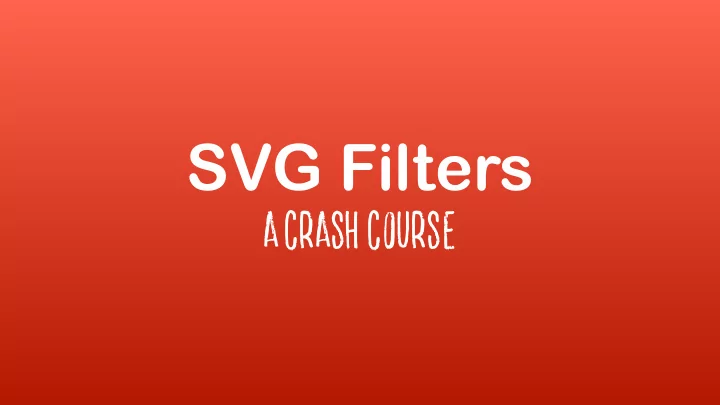

SVG Filters A Crash Course
• blur() • brightness() • contrast() • grayscale() • hue-rotate() • invert() • opacity() • saturate() • sepia() • drop-shadow() • url()
filter: blur(6px);
https://codepen.io/SaraSoueidan/pen/314d9e441fc1591041571f5326e329c4?editors=1000
Why?
1.Content semantics are preserved. 2.The content is editable and dynamic. 3.Easier and faster to tweak and change. 4.The effects are animatable.
<filter>
<svg width="600" height="450" viewBox="0 0 600 450"> <filter id="myFilter"> <!-- filter operations go here --> </filter> <image xlink:href="..." width="100%" height="100%" x="0" y="0" filter="url(#myFilter)"></image> </svg>
<svg width="600" height="400" viewBox="0 0 850 650"> <filter id=“filter"> <feOffset in="SourceAlpha" dx="20" dy=“20"></feOffset> <feGaussianBlur stdDeviation="10" result=“DROP"></feGaussianBlur> <feFlood flood-color="#000" result="COLOR"></feFlood> <feComposite in="DROP" in2="COLOR" operator="in" result="SHADOW1"></feComposite> <feComponentTransfer in="SHADOW1" result="SHADOW"> <feFuncA type="table" tableValues="0 0.5"></feFuncA> </feComponentTransfer> <feMerge> <feMergeNode in="SHADOW"></feMergeNode> <feMergeNode in="SourceGraphic"></feMergeNode> </feMerge> </filter> <image xlink:href="..."x="0" y="0" width="100%" height="100%" filter="url(#filter)"></image> </svg>
The Filter Region
It is o'en necessary to provide padding space in the filter region because the filter effect might impact bits slightly outside the 5ght-fi7ng bounding box on a given object. For these purposes, it is possible to provide nega5ve percentage values for ‘x’ and ‘y’, and percentages values greater than 100% for ‘width’ and ‘height’. <filter x="-10%" y="-10%" width="120%" height="120%" filterUnits="objectBoundingBox"> <!-- filter operations here--> </filter>
Visualizing the filter region with a color flood <filter id=“filter"> <feFlood flood-color=“#EB0066" result=“FLOOD"> </feFlood> <feMerge> <feMergeNode in="FLOOD" /> <feMergeNode in="SourceGraphic" /> </feMerge> </filter>
<!-- Using objectBoundingBox units --> <filter id="filter" x=“5%" y=“5%” width="100%" height=“100%”> <!-- Using userSpaceOnUse units --> <filter id=“filter" filterUnits="userSpaceOnUse" x=“5px" y=“5px” width="500px" height="350px">
Creating a drop shadow
<filter id=“filter”> <feOffset in="SourceAlpha" dx="20" dy=“20"></feOffset> <feGaussianBlur stdDeviation="10" result="DROP"></feGaussianBlur>
<filter id=“filter"> <feOffset in="SourceAlpha" dx="20" dy="20"></feOffset> <feGaussianBlur stdDeviation="10" result="DROP"></feGaussianBlur> <feFlood flood-color="#bbb" result=“COLOR"></feFlood> <feComposite in="COLOR" in2="DROP" operator="in" result=“SHADOW"> </feComposite>
Compositing Compositing is the combining of a graphic element with its backdrop. A backdrop is the content behind the element and is what the element is composited with. Compositing defines how what you want to draw will be blended with what is already drawn on the canvas. The source is what you want to draw, and the destination is what is already drawn (the backdrop). So, if you have two elements, and these elements overlap, you can think of the element on top as being the source, and the parts of the element behind that lie beneath it, will be the destination.
https://www.sarasoueidan.com/blog/compositing-and-blending-in-css/
<filter id=“filter"> <feOffset in="SourceAlpha" dx="20" dy="20"></feOffset> <feGaussianBlur stdDeviation="10" result="DROP"></feGaussianBlur> <feFlood flood-color="#bbb" result=“COLOR"></feFlood> <feComposite in="COLOR" in2="DROP" operator="in" result=“SHADOW"> </feComposite> <feMerge> <feMergeNode in="SHADOW" /> <feMergeNode in="SourceGraphic" /> </feMerge> </filter>
feMorphology
To morph means to transform the form or the shape of an object. The morphology filter operates on the form of an object. It provides two specific shape transformations: erosion (thinning or shrinking) and dilation (thickening or expanding). <feMorphology in=“..” result="dilated" operator="dilate" radius="3"></feMorphology>
https://codepen.io/SaraSoueidan/pen/84009b2595648273d13c342fd38728ec/?editors=1100
1. erode (the default) sets each pixel to its darkest or most transparent neighbor, respectively for each of the R, G, B, and A channels. 2. dilate sets each channel of each pixel to match the brightest or least transparent value from its neighbors, for each channel respectively.
<text font-size="80px" font-weight="700" dx="100" dy="200" stroke="deepPink" stroke-width="3px"> Stroked Text </text>
<filter id="dilate"> <feMorphology in="SourceAlpha" result="dilated" operator="dilate" radius="3"></feMorphology> <feFlood flood-color="deepPink" flood-opacity="1" result="PINK"></feFlood> <feComposite in="PINK" in2="dilated" result="recolored" operator="in"></feComposite> <feMerge> <feMergeNode in="recolored" /> <feMergeNode in="SourceGraphic" /> </feMerge> </filter> <text ... filter="url(#dilate)">Dilated Text</text>
<svg width="900" height="450" viewBox="0 0 900 450”> <filter id="myFilter" filterUnits="userSpaceOnUse"> <feMorphology operator="dilate" radius="8" in="SourceGraphic" result="THICKNESS" /> <feComposite operator="out" in="THICKNESS" in2="SourceGraphic"></feComposite> </filter> <text dx="100" dy="300" filter="url(#myFilter)">New York</text> </svg>
Applying Texture
A displacement map is an image whose color information is used to distort the content of another element. In SVG Filters, the feDisplacementMap primitive uses the pixels values from the image from in2 to spatially displace the image from in .
1. Desaturate the image. 2. Reduce the amount of detail in it by blurring it by 1px. 3. Save it as a displacement map. 4. Create text, and apply a distortion filter using the image as a displacement map. 5. Re-use the original image as a background behind the text. 6. Then refine the effect more by adding a slight transparency to the text and blending it with the background image.
1. Fill the filter region area with the image that will be used as a texture (using feImage). 2. Desaturate the image (using feColorMatrix value=“saturate” ) 3. Apply a 1px Gaussian blur to the image (using feGaussianBlur ) 4. Use the image to distort the text with feDisplacementMap . 5. Blend the text into the background image (using feBlend ) and apply a translucent effect to it (decrease opacity using feComponentTransfer ) to make the effect look more realistic. 6. Display the text and the image behind it by merging the two layers (using feMerge ).
<svg width="600px" height="330px" viewBox="0 0 600 330"> <defs> <filter id="texture" x="-50%" y="-50%" width="200%" height="200%"> <feImage xlink:href=".." x="0" y="0" width="100%" height="100%" preserveAspectRatio="none"></feImage> <!-- desaturate the image --> <feColorMatrix type="saturate" values="0" result="IMAGE" />
Recommend
More recommend